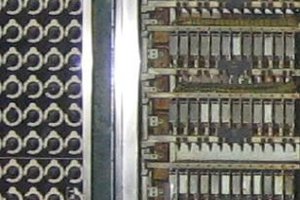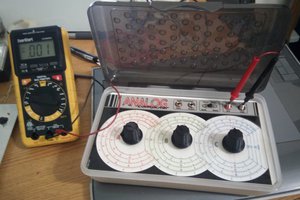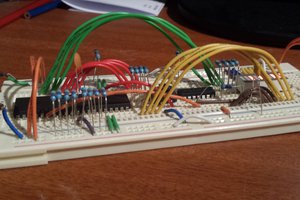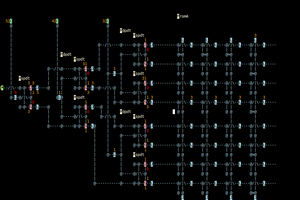PaperClip Computer
A few months ago I discovered "How to Build a Digital Computer That Works" and got excited about the project.
A few months ago I discovered "How to Build a Digital Computer That Works" and got excited about the project.
To make the experience fit your profile, pick a username and tell us what interests you.
We found and based on your interests.
Some days ago, I began to develop a unit capable to compare two numbers in order to add this capacity to my Paper Clip Computer.
Yeah, I know, I know.... the numbers that this computer can manage are small how to need a "comparator unit" but the pleasure was not in the "needed" but to build it and add it.
Searching the Internet I did not find a four-bit comparator circuit without chips; my goal was to follow the principles and philosophy of the computer: no chips, just basic electronic components and switches.
As I did not find any circuit, based on the book I created mine which is the one that I expose below.
This circuit is capable of comparing two four-bit numbers with the only limitation that both must be positive or negative; if one of them is negative, this will be the lowest.
I will try to build the circuit that will be integrated into the computer (and the drum) in a blank panel that is on the left of the model and it will look like this:
and Word n should indicate:
The result of these two parameters will indicate whether:
Word 1 = Word 2
Word 1 < Word 2
in the light panel.
The operation
The operation will be simple:
Step 1: Indicate is whether the numbers will be positive or negative.
Step 2: Select the position of the individual bits.
Answer: Read the result and use it according to the instructions of the program.
Today I finished wiring the Control Panel. From the beginning of the project I tried to make it modular since the search for possible errors and maintenance would be much easier.
Making the system modular consumes more time since instead of just "placing" a cable I placed terminals and connectors; debugging or replacing damaged components should be easier this way.
All cables and connectors are either color-coded (I used network cables) or are numbered so they can be easily identified. I also made an Excel with the cable-number-computer word equivalences to print it and stick it on the inside of the back cover and include it in the operations and maintenance manual.
With this modular format I can quickly disconnect all the panels to remove them from the chassis, repair them independently from the rest of the equipment and once tested, reconnect them.
Create an account to leave a comment. Already have an account? Log In.
Thank you for the comment! I worked in Xerox in the nineties and I learned how the printers works with computers and, yes, I remember the ozono smell when print... now the printers and copiers doesn´t smell likes olds ones.. ;-)
I also had that book back in the 70's and started to build one but got distracted. I now have the book on my laptop so perhaps someday.... That is a lovely work of functional art, so cool :-D
Thank you for your comment! I hope my project excites you to start yours!
Nice project, but please be very, very careful with those paperclips!
https://www.decisionproblem.com/paperclips/
:o)
Thanks for the comnment! I will try to be careful ... although it will be difficult since the ones I bought to make the "reading heads" have not worked very well for me, so I will have to buy another brand of "heads" ;-)
I love what you have done. Welcome to the small pretty exclusive club of people that have actually built a "Working Digital Computer".
Thank you for the comment. I was surprised that very few computer hobbyists there were interested to build this project. I saw few info about constrution and and looking for help because some items in the book was not clear for my (english isn´t my mother tongue) and some points I did was for try and error; for example, in the chaper about the Aritmetic Unit there is a non-used switch... When I saw it, I read again the chapter because I thought that was an interpretation error, but no, I runed an ALU test like book describes and it works. I think that authors thought another "logic" but change his mind...
It does seem like a strange omission from "common knowledge" of home/hobby computer history. Some people here remember the book personally, but apparently no one who writes about early computing has met anyone who had the book. ?. Thanks for writing it up!
Very cool, I had that book too. You can tell how dated it is now by its assumption that wooden thread spools were a common item. But I always appreciate modern takes on the PCC. Looking forward to build details.
Hi Dan, Thanks for the comment. I was tempted to make my own multiswitch.... but Amazon change my mind very quick! ;-)
In a moment I will post some updates for today, January 23.
Become a member to follow this project and never miss any updates

 Stefano
Stefano
 deftcoyote
deftcoyote
 Dominic11112
Dominic11112
Simply wonderful! I'd forgotten about this book on my bookshelf. This along, with early Xerox copies (the ones that felt waxy and smelled funny) of the Cosmac Elf articles from Popular Electronics helped foster my early understanding of computers and digital logic.
I see that archive.org has a scanned copy of the book available.
https://archive.org/details/bitsavers_paperClipCorkingDigitalComputerJun67_11243437
Now that I'm waxing poetic - a link to the Elf as well:
https://en.wikipedia.org/wiki/COSMAC_ELF